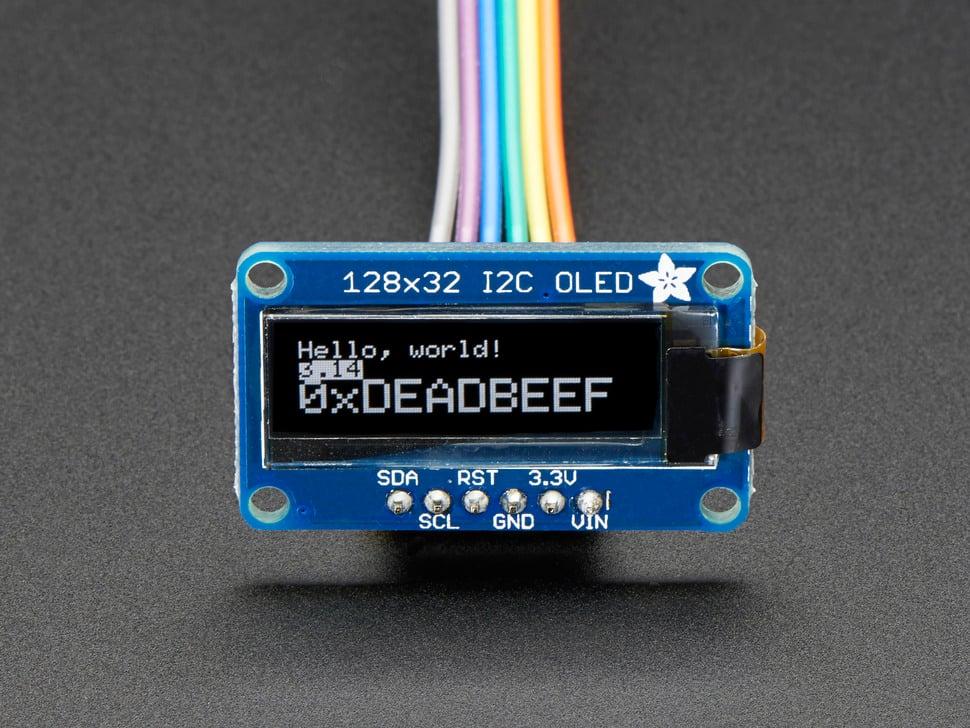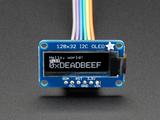Adafruit Monochrome 128x32 I2C OLED graphic display

Description
These displays are small, only about 1" diagonal, but very readable due to the high contrast of an OLED display. This display is made of 128x32 individual white OLED pixels, each one turned on or off by the controller chip. Because the display makes its own light, no backlight is needed.
This design feature reduces the power required to run the OLED, resulting in high contrast and remarkable crispness. The driver chip SSD1306 communicates via I2C, requiring only 3 pins, two of which are I2C data/clock pins. This model includes auto-reset circuitry and a STEMMA QT / Qwiic connector.
The OLED and driver require a 3.3V power supply and logic levels for communication. To enhance compatibility, a 3.3v regulator and level shifter are included, allowing use with any 5V microcontroller, such as Arduino. Power consumption averages around 20mA depending on display usage.
A simple switch-cap charge pump, built into the OLED driver, converts 3.3v-5v into a high voltage drive for the OLEDs, simplifying integration into projects. In addition to providing a datasheet, a detailed tutorial and example code in an Arduino library are available, facilitating text and graphics display. The code requires a microcontroller with over 512 bytes of RAM for buffering but ensures fast performance.
Note that keeping each OLED pixel continuously illuminated for over 1000 hours may result in dimming, so turning off the display when not in use is recommended to maintain brightness.
Properties
| Brand | Adafruit |
| Model | 931 |
ETA is not known
Customer questions
Customer Reviews
- In stock Adafruit NOOds - Flexible LED Filament - 3V 300mm long - Red € 7,25 View product
- In stock Adafruit IR Break Beam Sensors with Premium Wire Header Ends - 3mm LEDs € 2,90 View product
- In stock Adafruit Breadboard-friendly 2.1mm DC barrel jack € 1,05 View product
- In stock Adafruit IR Break Beam Sensor with Premium Wire Header Ends - 5mm LEDs € 5,80 View product
- In stock Adafruit Small Enclosed Piezo w/Wires € 1,05 View product
- In stock Adafruit Mini Basic PIR Sensor - BL412 € 2,10 View product
- In stock Adafruit Stainless Thin Conductive Thread - 2 ply - 23 meter/76 ft € 6,85 View product
- In stock Adafruit NOOds - Flexible LED Filament - 3V 300mm long - Blue € 7,25 View product
- In stock Adafruit 2 x CR2032 Coin Cell Battery Holder - 6V output - On/Off switch € 2,10 View product
- In stock Adafruit Pressure-Sensitive Conductive Sheet (Velostat/Linqstat) € 4,75 View product
- In stock Adafruit Stacking Headers for Feather - 12-pin and 16-pin female headers € 1,25 View product
- In stock Adafruit Stereo 3.7W Class D Audio Amplifier - MAX98306 € 8,70 View product
- In stock Adafruit Mono 2.5W Class D Audio Amplifier - PAM8302 € 3,95 View product
- In stock Adafruit White LED Backlight Module - Medium 23mm x 75mm € 2,50 View product
- In stock Adafruit NOOds - Flexible LED Filament - 3V 300mm long - Lime Green € 6,85 View product
Recently viewed items
- Adafruit Monochrome 128x32 I2C OLED graphic display € 9,75 View product
- Adafruit BME680 - Temperature, Humidity, Pressure and Gas Sensor € 18,20 View product
- Adafruit Proto Plate for Beagle Bone & Beagle Bone Black € 7,65 View product
- Adafruit RFID RFID/NFC S50 Card Reader - PS/2 Interface € 38,45 View product
- Adafruit HUZZAH CC3000 WiFi Shield with Onboard Antenna € 38,45 View product
- Adafruit IBM TJBot – A Watson Maker Kit € 144,05 View product
- Adafruit 8x16 LED Matrix FeatherWing w/o Matrices € 7,65 View product
- Adafruit Blinka the CircuitPython Sticker € 1,25 View product
- Adafruit ESP32 Feather V2 w.FL Antenna - 8MB Flash + 2 MB PSRAM € 19,25 View product
- Adafruit Red DSA Keycaps for MX Compatible Switches - 10 pack € 5,80 View product
- Adafruit Particle Ethernet FeatherWing € 19,25 View product
- Adafruit Feather M4 CAN Express with ATSAME51 € 24,- View product
- Adafruit Triple-axis Magnetometer - MMC5603 € 5,80 View product
- Adafruit Light Up Key Switch Keychain - Blue LED € 7,65 View product
- Adafruit Kailh CHOC Low Profile Red Linear Key Switches - 10-pack € 11,60 View product










